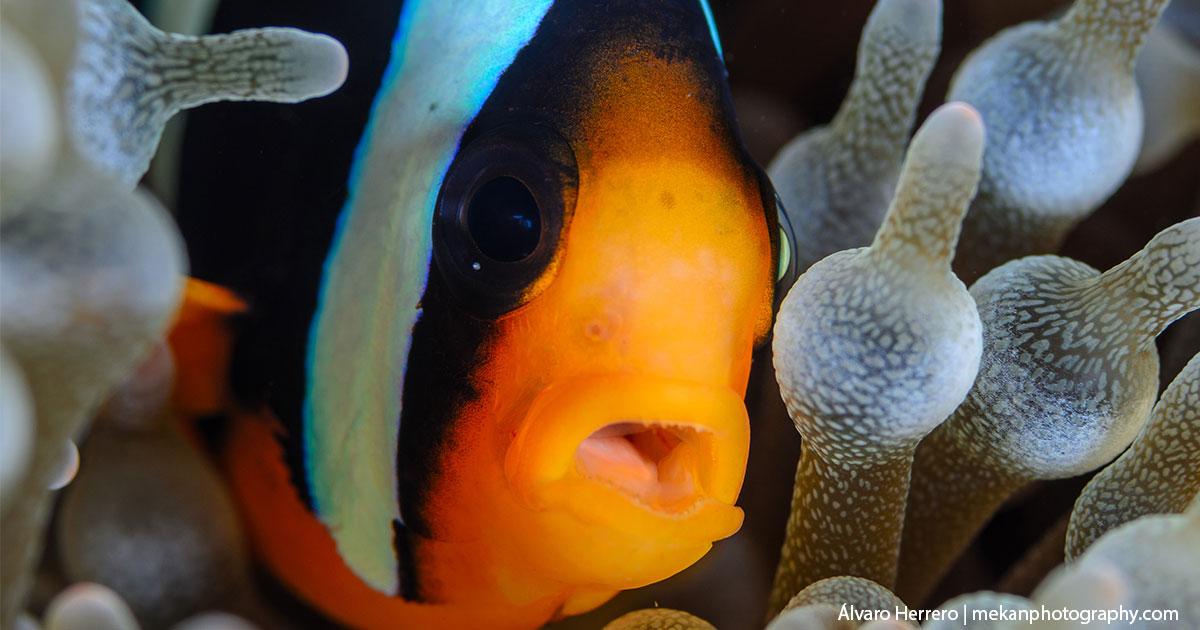
Clown Fish is a term used by some people to refer to one or two species, and used by others to talk about all Anemonefish. Whether you want to know more about ‘Nemo’ or his many cousins, this page may answer some questions and at the same time raise a few more. Clown Fish are among the most-popular fish at The Similans, and all but the fussiest scuba divers will take the time to stop or slow down for a moment to admire these wonderful & amazing little fish. Worldwide there are nearly 30 different species of anemonefish, but only a few live in Thailand. As for the famous Nemo, this is just one species of anemonefish.
What Are Anemonefish?
Anemonefish are any of the nearly 30 species of Amphiprioninae, Perch-like fish that make up more than 40% of all bony fish species found in the world’s seas, oceans, rivers & lakes. They are in the Family of Pomacentridae which also includes Damselfish. They are small fish, with the largest specimens growing to 16-18 cm. in length. All anemonefish live in tropical and sub-tropical salt water. As their name suggests, anemonefish spend most of their time swimming within the tentacles of anemones. They do this to stay safe from predators, but there are also benefits for the host anemone. As for underwater photographers, this also makes them even better models, with their perfect backgrounds.
So what’s an anemone?
Sea anemones are technically animals, but they look like a kind of underwater plant. Their name is derived from the anemone flower. They are classed in the same phylum (Cnidaria) as corals & jellyfish. The polyp of an anemone makes its base on a hard surface and from that grows into a beautiful creature. However, this beauty is a mouth surrounded by tentacles that are covered in millions of venomous stinging barbs (nematocysts).
In the wild, anemones can live without anemonefish much more easily than the fish can live without an anemone as a host.
Which species of Anemonefish / Clown Fish can be found in Thailand?
- Clown Anemonefish
- False Clown Anemonefish
- Clark’s Anemonefish
- Pink Skunk Anemonefish
- Red Saddleback Anemonefish
- Tomato clownfish
These are the six main species of anemonefish most-commonly seen in Thai waters. While four are easy to identify, the first two are not. And this is where the discussion about which species Nemo depicts in the movie. Because Nemo and his family were CGI creations, science or biologists can’t prove who may be right or wrong.
Clown Anemonefish
Clown Anemonefish (Amphiprion percula) is the true ‘Clown Fish.’ It is identified by being bright orange and having three broad white bands along its flanks. Each of the white bands has a narrow black border to the adjoining orange areas. They rarely grow to more than 8cm. in length. Prior to mating, both the mature male and female change their behaviour noticeably.
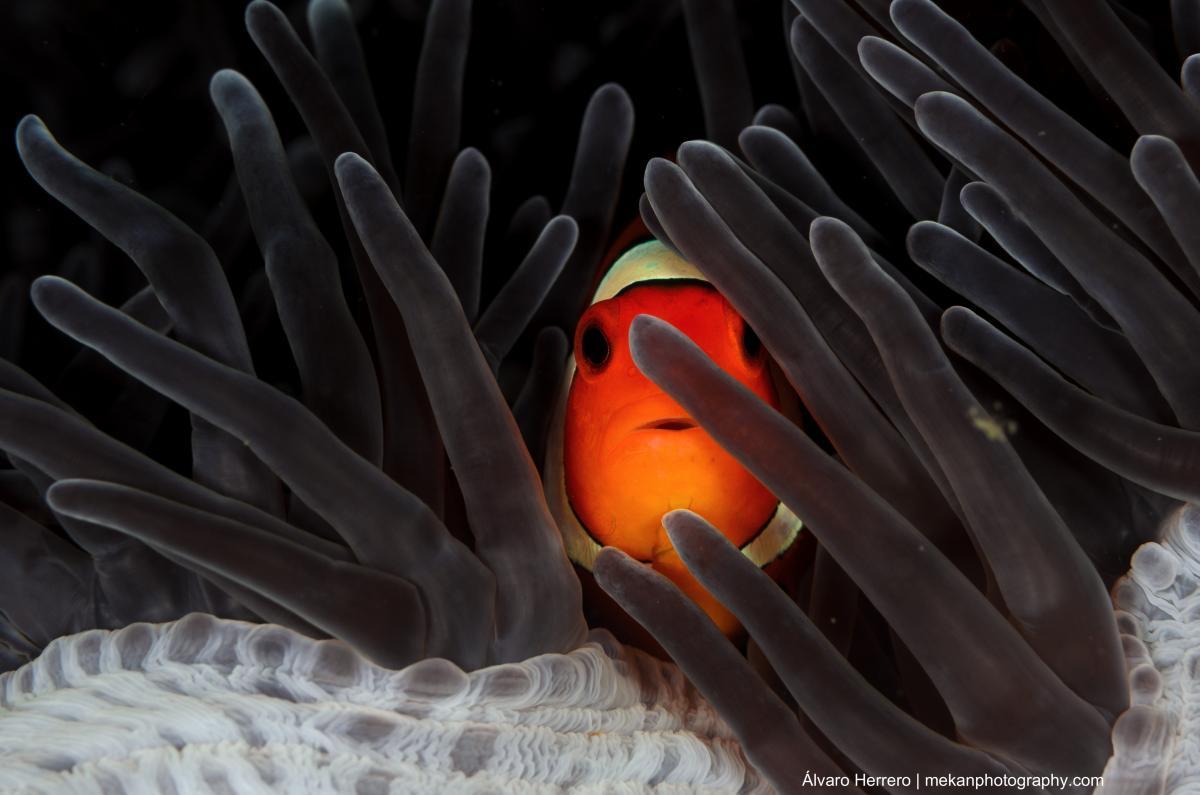 Clown Anemonefish (photo by Alvaro Herrero Mekan Photography)
Clown Anemonefish (photo by Alvaro Herrero Mekan Photography)
False Clown Anemonefish
False Clown Anemonefish (Amphiprion ocellaris) is most likely the species that the Pixar movie Finding Nemo was based on. Only very experienced experts can easily distinguish a False and true Clown Anemonefish, due to the physical differences being so small. Like the Clown Fish, this species is bright orange with white bands separated by black lines. However, the black lines of the False Clownfish are slightly thinner. They can also grow slightly larger than true Clown Fish.
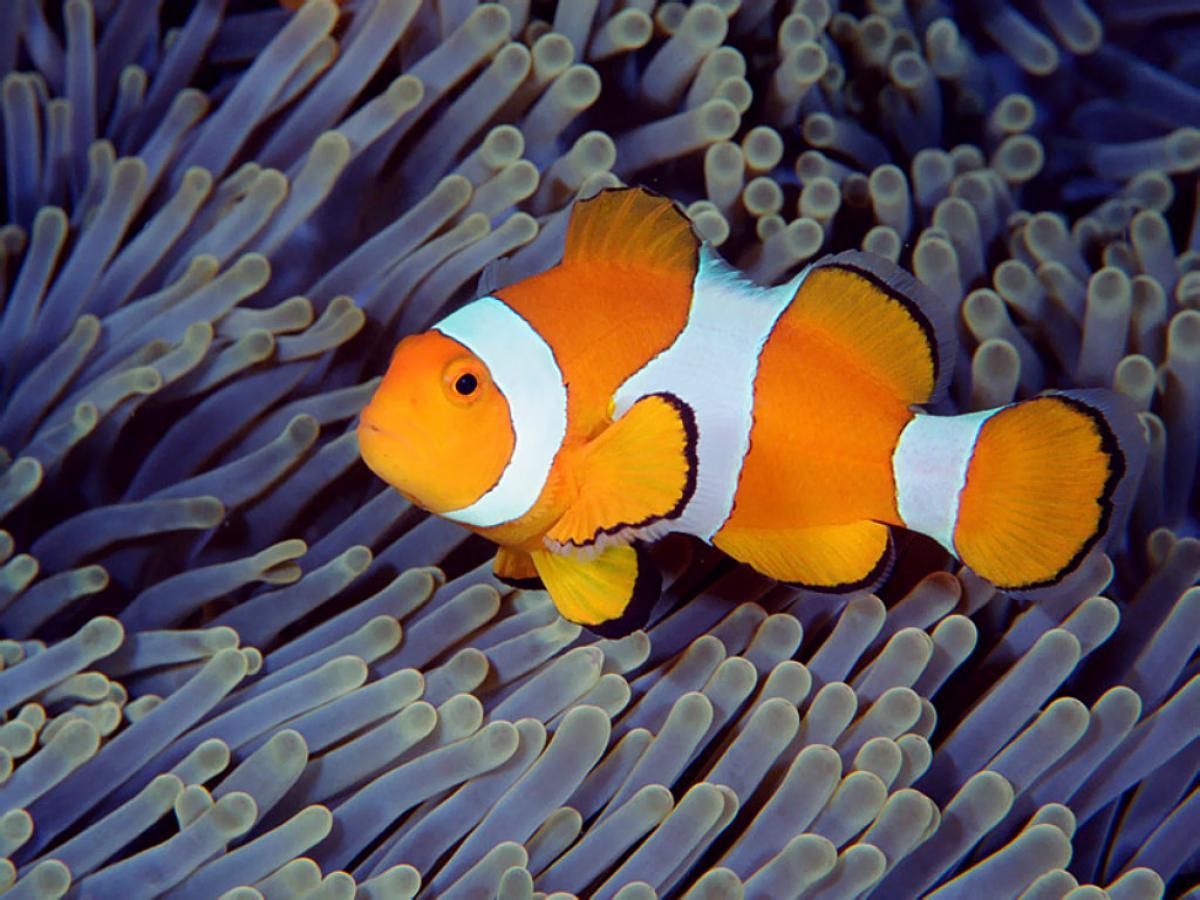 False Clown Anemonefish
False Clown Anemonefish
Clark’s Anemonefish
Clark’s Anemonefish (Amphiprion clarkii) is a distinctly different fish to look at. It has large black areas along its body where the clownfish is orange. However, in many cases the Clark’s Anemonefish has an orange face. In addition, it grows to be one of the largest species of anemonefish. This is one of the most vocal species, and many are recorded making sounds which scientists believe is communication among the group. It is also believed that this species can live with the greatest variety of anemone host species.
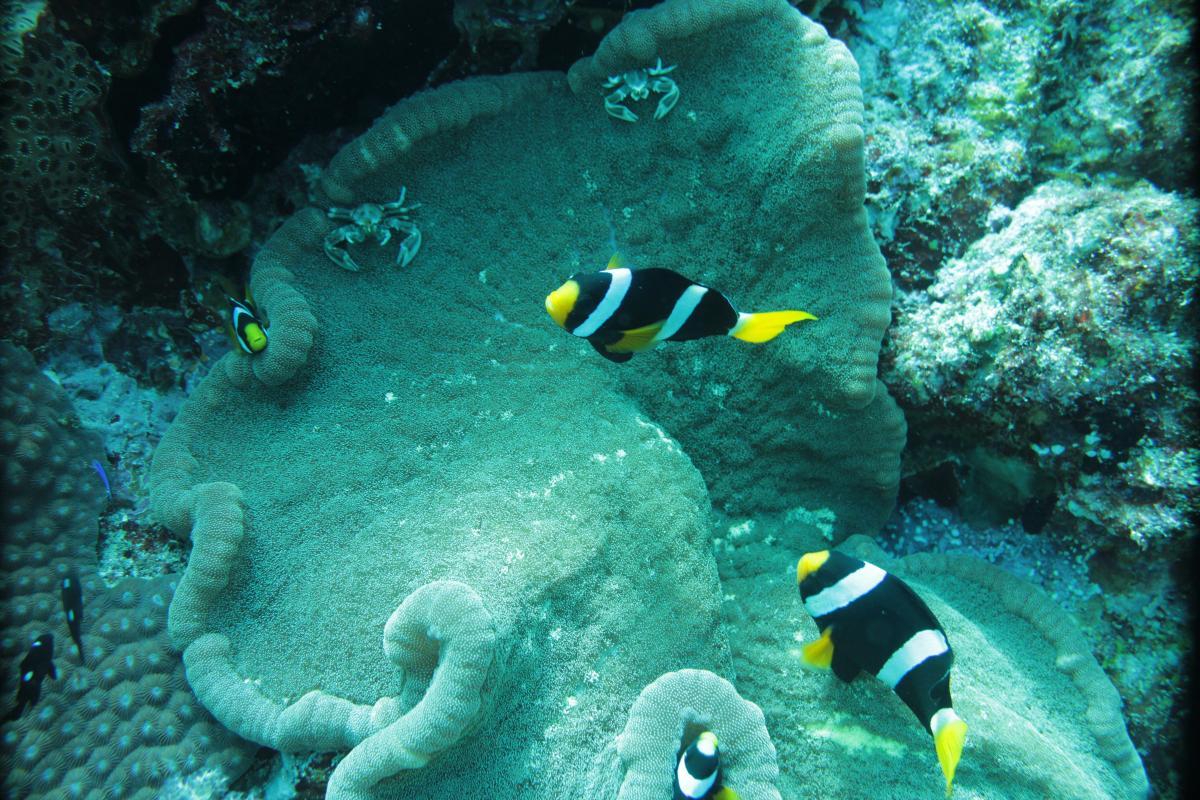 Clarks Anemomonefish
Clarks Anemomonefish
Pink Skunk Anemonefish
Pink Skunk Anemonefish (Amphiprion perideraion) is a distinctive-looking species and many divers’ favourite. Its name refers to a skunk due to the white band along its back (dorsal ridge). This species also has a vertical white stripe just behind its eye on both sides. The Pink Skunk Anemonefish usually has a peach-coloured body. They can grow up to 10cm. in length.
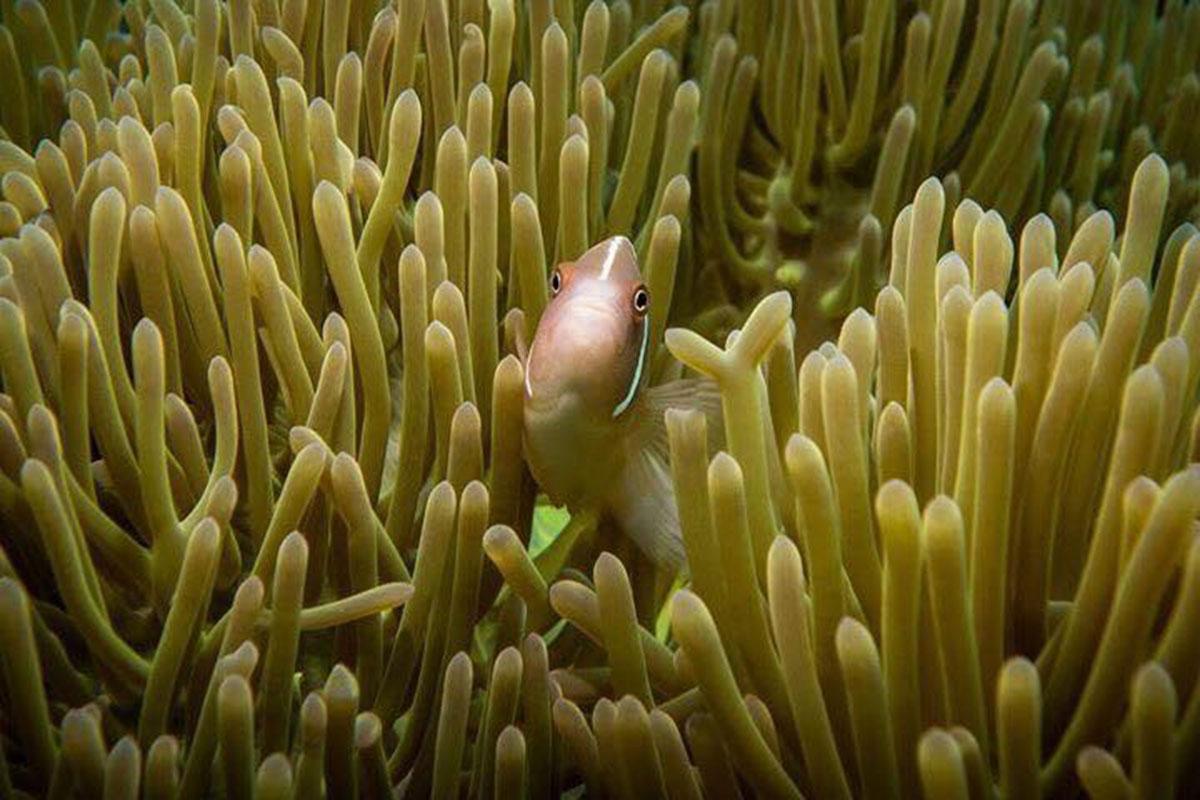 Pink Skunk Anemonefish (photo by Kevin Michael Gacad KMG Films)
Pink Skunk Anemonefish (photo by Kevin Michael Gacad KMG Films)
Red Saddleback Anemonefish
Red Saddleback Anemonefish (Amphiprion ephippium) is a larger species and can grow to 15cm. in length. The name refers to the markings on its back which are similar to the saddle of a horse. They are not normally seen in water deeper than 18m.
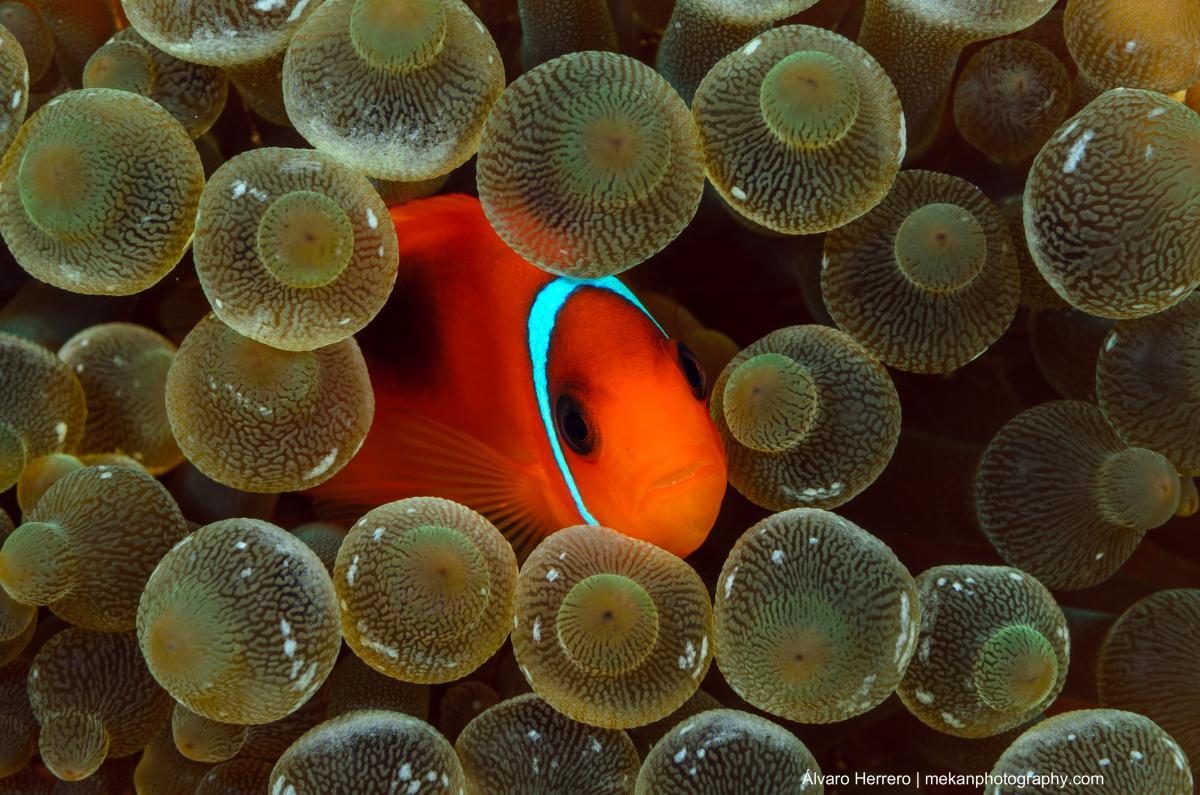 Red Saddleback Anemonefish (photo by Alvaro Herrero Mekan Photography)
Red Saddleback Anemonefish (photo by Alvaro Herrero Mekan Photography)
Tomato clownfish
Tomato clownfish (Amphiprion frenatus) is seen in Thai waters, but not as frequently as the other species on this page. The females are larger than the males and darker in colour. As the names suggests, this fish is red in colour. Also, it has one thick white band over its head and down each side of its face, behind its eyes. There is a thin black border between this white band and the red body. As they get older their colouration becomes darker.
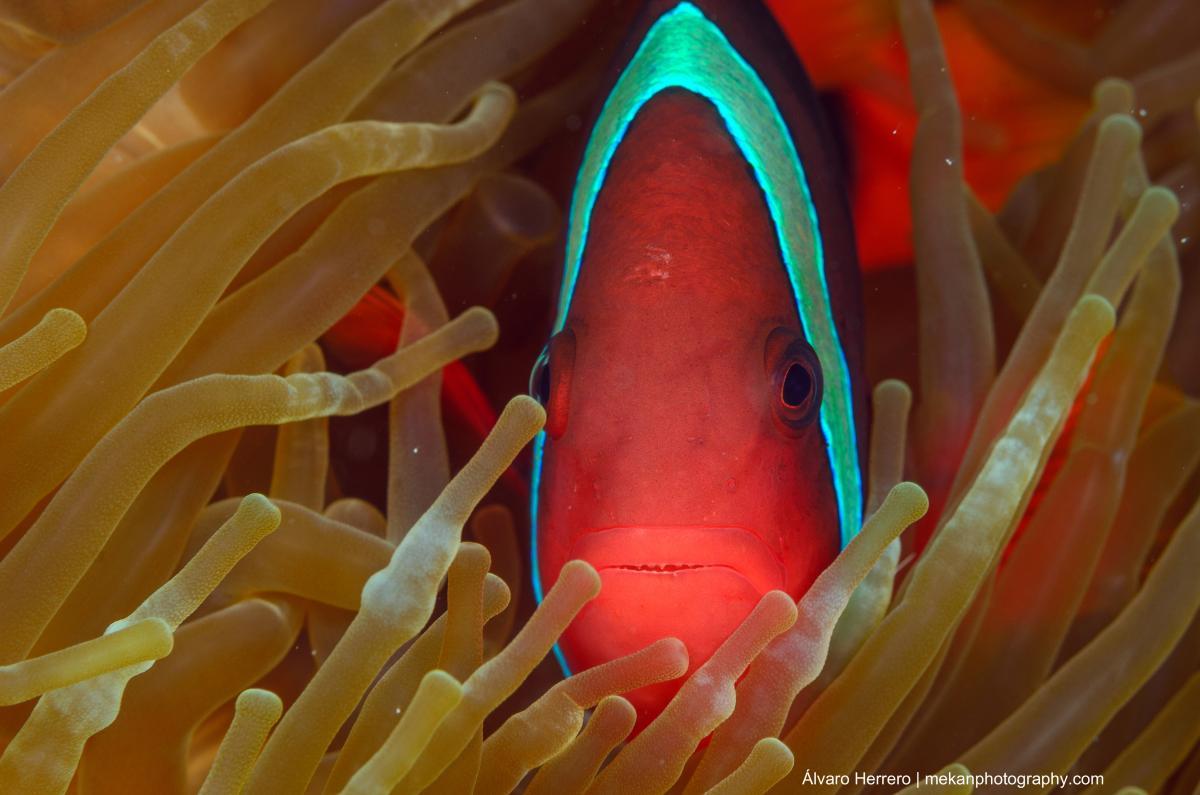 Tomato Anemonefish (photo by Alvaro Herrero Mekan Photography)
Tomato Anemonefish (photo by Alvaro Herrero Mekan Photography)
Clown Fish Behaviour
Symbiosis with host anemones is what defines anemonefish. The fish make a home within the venomous tentacles of their host anemone. The anemone protects the fish from predators at the same time as providing it with food, and a place for some species to lay eggs. In return, the fish clears parasites, eats the anemone’s dead tentacles, protects it from predators, and the faeces of the fish provide nutrients for the anemone. It is also believed that the bright colours of the fish attract other species to the anemone, which then become its prey.
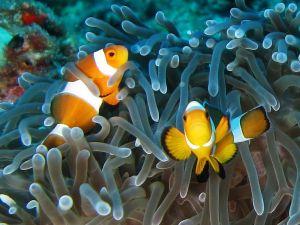 Immunity to the venomous nematocysts of the host anemone is another hotly-disputed topic even among experts. It is generally believed that anemonefish produce a mucus over their bodies that protects them from the venom of the hosts’ tentacles. And they refresh this immunity by continually rubbing parts of their bodies on the tentacles. However, other theories claim that the membrane around the fish is sugar based and not protein based and this prevents the anemone’s tentacles from reacting with a sting. Or, that the way that the fish swim around the tentacles suggests to the anemone that the fish is not food.
Immunity to the venomous nematocysts of the host anemone is another hotly-disputed topic even among experts. It is generally believed that anemonefish produce a mucus over their bodies that protects them from the venom of the hosts’ tentacles. And they refresh this immunity by continually rubbing parts of their bodies on the tentacles. However, other theories claim that the membrane around the fish is sugar based and not protein based and this prevents the anemone’s tentacles from reacting with a sting. Or, that the way that the fish swim around the tentacles suggests to the anemone that the fish is not food.
Feeding by anemonefish as already mentioned, includes parasites & algae from the scraps that the anemone doesn’t eat. In addition, digested food that the anemone expels can also provide nutrition for the fish. They are also known to eat dead tentacles of the anemone. In general, most anemonefish species are omnivorous, eating zooplankton and algae.
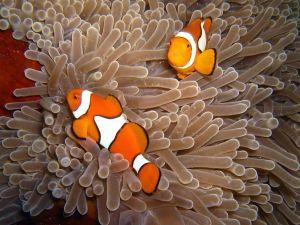 Clown Anemonefish (photo by Henry and Tersia)Reproduction involves sexual reproduction that takes places by external fertilization, usually just after dark near a full moon. Depending on the species, the breeding male or female will prepare the nest, usually by removing debris and algae. Sometimes, a certain action by the fish will cause the anemone to contract its tentacles, which leaves a perfect area of smooth anemone skin on which eggs are laid. Saddleback Anemonefish need a hard surface to lay their eggs on. This species has been recorded using teamwork to drag an item, such as a coconut husk, towards their host anemone in order for the female to lay her eggs on. 6-10 days later, the eggs hatch and the fry drift in the current before settling to grow into juveniles. All anemonefish are born male.
Clown Anemonefish (photo by Henry and Tersia)Reproduction involves sexual reproduction that takes places by external fertilization, usually just after dark near a full moon. Depending on the species, the breeding male or female will prepare the nest, usually by removing debris and algae. Sometimes, a certain action by the fish will cause the anemone to contract its tentacles, which leaves a perfect area of smooth anemone skin on which eggs are laid. Saddleback Anemonefish need a hard surface to lay their eggs on. This species has been recorded using teamwork to drag an item, such as a coconut husk, towards their host anemone in order for the female to lay her eggs on. 6-10 days later, the eggs hatch and the fry drift in the current before settling to grow into juveniles. All anemonefish are born male.
Anemonefish undergo sex change. They are all born male, and remain male during their juvenile stage until they become adult. This is due to the social hierarchy within anemonefish groups. Each group of anemonefish in a host consists of just one female and one breeding male. The female is the largest member of the group, and the breeding male is usually the second largest. The other individuals are non-breeding males. As soon as the female is no longer present (usually due to death) the largest male undergoes the transition to become a female. This usually takes 1-2 weeks. At the same time, the highest-ranking non-breeding male will mature to become a breeding male.
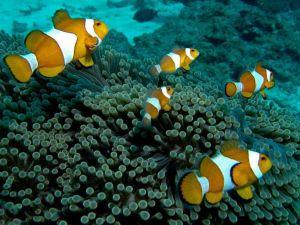 Some species of anemonefish can be aquarium pets. However, it is unfair to remove wild fish from their natural habitat. Captive-bred individuals fair quite well in aquariums, but it’s much more difficult to keep an anemone in an aquarium to use as a host. Therefore, most aquarium anemonefish don’t have a natural host, and this can only cause stress for them, even if they were born in captivity.
Some species of anemonefish can be aquarium pets. However, it is unfair to remove wild fish from their natural habitat. Captive-bred individuals fair quite well in aquariums, but it’s much more difficult to keep an anemone in an aquarium to use as a host. Therefore, most aquarium anemonefish don’t have a natural host, and this can only cause stress for them, even if they were born in captivity.
The range, distribution & habitat of anemonefish depend on the species. But in general, they all live in tropical or sub-tropical salt water around the world at depths from 3-30 metres, mostly 12-20m. Although reefs that are exposed to currents supply more food, in general most anemonefish and their hosts are found in sheltered or slightly-sheltered water.
Almost all species are territorial and appear to show no fear in trying to attack larger species (including humans) who the fish believe may be a threat to the host anemone. Even if an anemonefish bites you, it would neither hurt nor be a problem after the dive. However, it’s unfair to use this fact in order to touch them or get the best photograph. In any case, it’s likely that the venomous barbs of the anemone will give any overzealous diver a nasty sting.
Which Species Is Nemo?
Nemo is based on one of two species of anemonefish. These are the Clown Anemonefish (Amphiprion percula) and the False Clown Anemonefish (Amphiprion ocellaris). Both are found on the east coast of Australia, which is where Nemo was first taken from the sea, and both these species look almost identical. While some scuba diving professionals may claim to be able to identify one species over another, the differences are so small that without having a specimen of each next to one another, it’s almost impossible. The general consensus is that Nemo is a False Clown Anemonefish (Amphiprion ocellaris) due to him having slightly thinner black borders between the orange and the white areas, especially on his pectoral fins.


